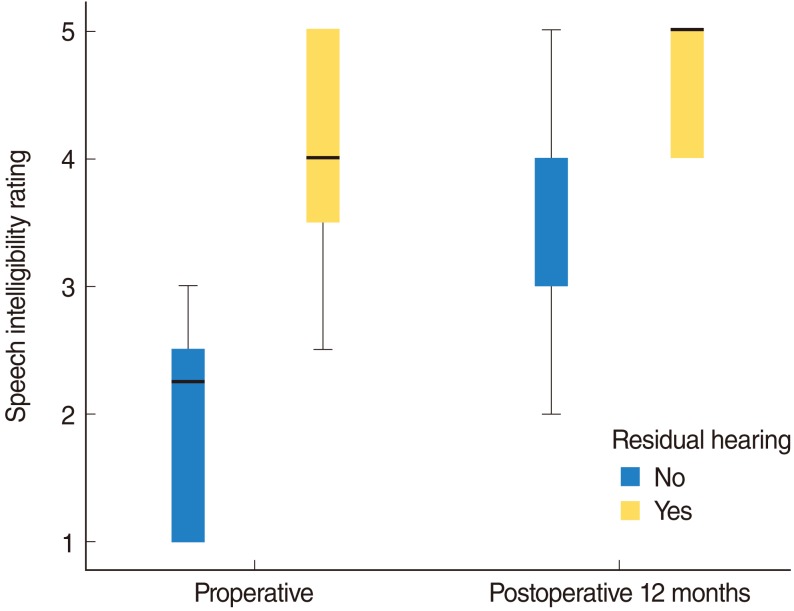Clin Exp Otorhinolaryngol.
2012 Apr;5(Suppl 1):S69-S72.
Preoperative Voice Parameters Affect the Postoperative Speech Intelligibility in Patients with Cochlear Implantation
- Affiliations
-
- 1Department of Otolaryngology, Asan Medical Center, University of Ulsan College of Medicine, Seoul, Korea. jwchung@amc.seoul.kr
Abstract
OBJECTIVES
Verbal communication depends on a good function of voice and speech organs. Some of the voice characteristics of deaf people differ considerably from those of speakers with normal hearing. After cochlear implantation (CI), auditory control of voice production is possible and the quality of the voice is improved. CI improves quality of voice, speech and hearing with deafness. The aim of our study was to investigate the relationship between acoustic analysis before CI and the speech intelligibility before and after CI.
METHODS
Twelve prelingually deafened children implanted unilaterally at the age of 3.4-9 years were included in the study. For all of the children an acoustic analysis of the Slovene vowel 'a' was performed before CI. The fundamental frequency (F0), jitter, shimmer and noise-to-harmonic ratio (NHR) were studied before the implantation. For all of the children the speech intelligibility was performed before and 12 months after CI. Preoperative hearing was divided on existing residual hearing. The results of the acoustic analyses and speech intelligibility before and after CI were compared for preoperative hearing. The results of the speech intelligibility were compared for the age of operation and preoperative acoustic analysis (F0, jitter, shimmer, NHR).
RESULTS
Preoperative hearing had no influence on preoperative voice analysis. The children with residual hearing had a high grade of speech intelligibility before and after CI. The preoperative shimmer had positive correlation with postoperative 12 month speech intelligibility (r=0.618, P=0.032). The preoperative jitter had positive correlation with postoperative 12 month speech intelligibility, but was not statistically significant (r=0.479, P=0.116).
CONCLUSION
Shimmer on preoperative voice analyses had influence on speech intelligibility after CI.
MeSH Terms
Figure
Reference
-
1. Angelocci AA, Kopp GA, Holbrook A. The vowel formants of deaf and normal-hearing eleven-to-fourteen-year-old boys. J Speech Hear Disord. 1964; 5. 29(2):156–160. PMID: 14147499.2. Higgins MB, McCleary EA, Carney AE, Schulte L. Longitudinal changes in children's speech and voice physiology after cochlear implantation. Ear Hear. 2003; 2. 24(1):48–70. PMID: 12598813.
Article3. Monsen RB. Acoustic qualities of phonation in young hearing-impaired children. J Speech Hear Res. 1979; 6. 22(2):270–288. PMID: 491555.
Article4. Leder SB, Spitzer JB, Milner P, Flevaris-Phillips C, Kirchner JC, Richardson F. Voice intensity of prospective cochlear implant candidates and normal hearing adult males. Laryngoscope. 1987; 2. 97(2):224–227. PMID: 3807627.
Article5. van den Broek P, Cohen N, O'Donoghue G, Fraysse B, Laszig R, Offeciers E. Cochlear implantation in children. Int J Pediatr Otorhinolaryngol. 1995; 6. 32(Suppl):S217–S223. PMID: 7665296.6. Richter B, Eissele S, Laszig R, Löhle E. Receptive and expressive language skills of 106 children with a minimum of 2 years' experience in hearing with a cochlear implant. Int J Pediatr Otorhinolaryngol. 2002; 6. 64(2):111–125. PMID: 12049824.
Article7. Moog JS, Geers AE. Speech and language acquisition in young children after cochlear implantation. Otolaryngol Clin North Am. 1999; 12. 32(6):1127–1141. PMID: 10523457.
Article8. Molina M, Huarte A, Cervera-Paz FJ, Manrique M, Garcia-Tapia R. Development of speech in 2-year-old children with cochlear implant. Int J Pediatr Otorhinolaryngol. 1999; 2. 47(2):177–179. PMID: 10206367.
Article9. Hocevar-Boltezar I, Vatovec J, Gros A, Zargi M. The influence of cochlear implantation on some voice parameters. Int J Pediatr Otorhinolaryngol. 2005; 12. 69(12):1635–1640. PMID: 15939488.
Article10. Seifert E, Oswald M, Bruns U, Vischer M, Kompis M, Haeusler R. Changes of voice and articulation in children with cochlear implants. Int J Pediatr Otorhinolaryngol. 2002; 11. 11. 66(2):115–123. PMID: 12393244.
Article11. van Dijkhuizen JN, Beers M, Boermans PP, Briaire JJ, Frijns JH. Speech intelligibility as a predictor of cochlear implant outcome in prelingually deafened adults. Ear Hear. 2011; Jul-Aug. 32(4):445–458. PMID: 21258238.
Article12. Calmels MN, Saliba I, Wanna G, Cochard N, Fillaux J, Deguine O, et al. Speech perception and speech intelligibility in children after cochlear implantation. Int J Pediatr Otorhinolaryngol. 2004; 3. 68(3):347–351. PMID: 15129946.
Article13. Hassan SM, Malki KH, Mesallam TA, Farahat M, Bukhari M, Murry T. The effect of cochlear implantation and post-operative rehabilitation on acoustic voice analysis in post-lingual hearing impaired adults. Eur Arch Otorhinolaryngol. 2011; 10. 268(10):1437–1442. PMID: 21331786.
Article14. Osberger MJ, Fisher L, Zimmerman-Phillips S, Geier L, Barker MJ. Speech recognition performance of older children with cochlear implants. Am J Otol. 1998; 3. 19(2):152–157. PMID: 9520050.15. Loundon N, Busquet D, Roger G, Moatti L, Garabedian EN. Audiophonological results after cochlear implantation in 40 congenitally deaf patients: preliminary results. Int J Pediatr Otorhinolaryngol. 2000; 11. 30. 56(1):9–21. PMID: 11074111.
Article16. Kaplan DM, Shipp DB, Chen JM, Ng AH, Nedzelski JM. Early-deafened adult cochlear implant users: assessment of outcomes. J Otolaryngol. 2003; 8. 32(4):245–249. PMID: 14587565.
Article
- Full Text Links
- Actions
-
Cited
- CITED
-
- Close
- Share
- Similar articles
-
- Gender difference in speech intelligibility using speech intelligibility tests and acoustic analyses
- Speech Intelligibility in Persian Hearing Impaired Children with Cochlear Implants and Hearing Aids
- Nasalance in Cochlear Implantees
- Clinical and Social Outcomes of Cochlear Implantation in Older Prelinguals
- Interpersonal Competence in College Students with Cochlear Implants: A Preliminary Study


